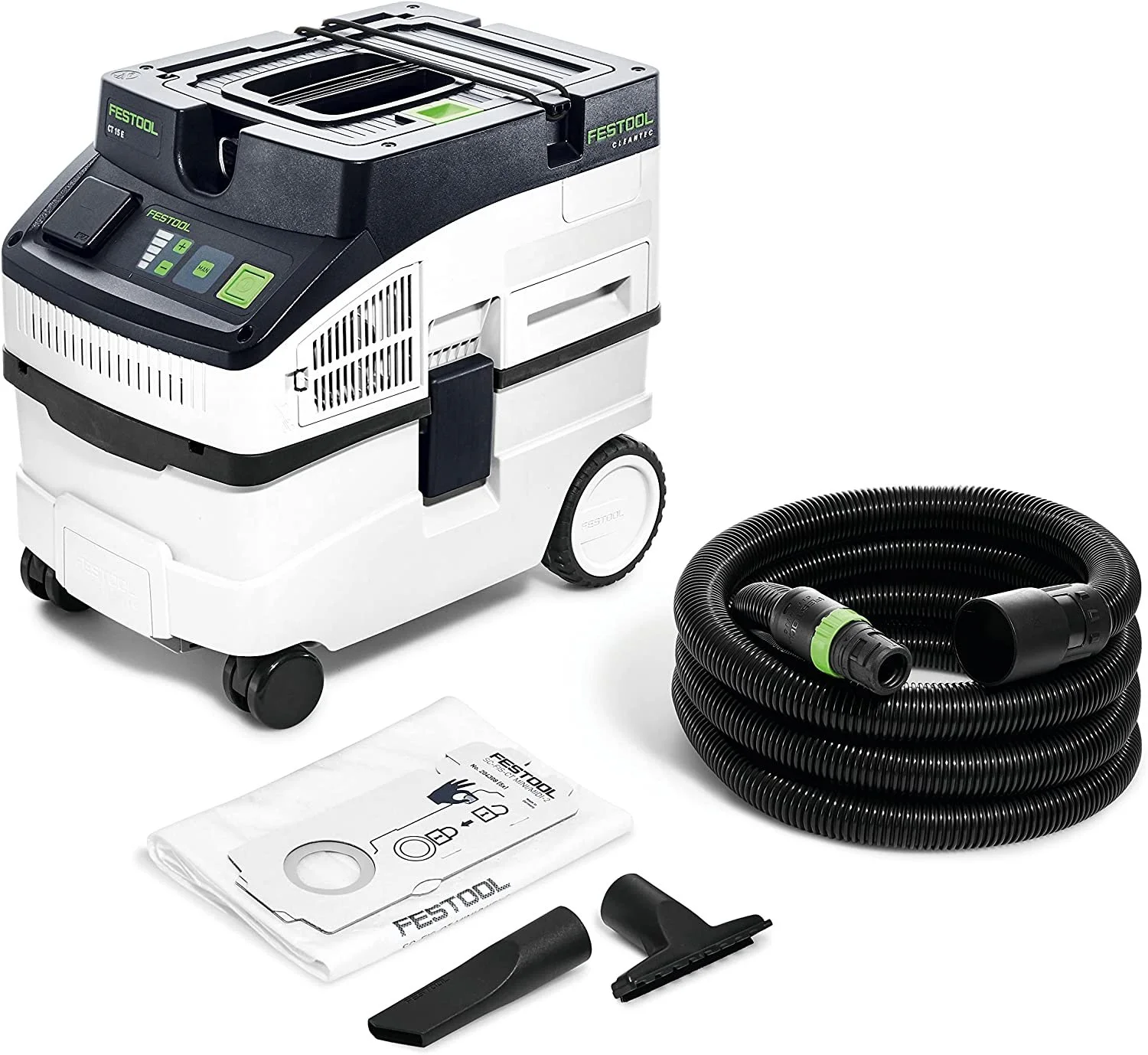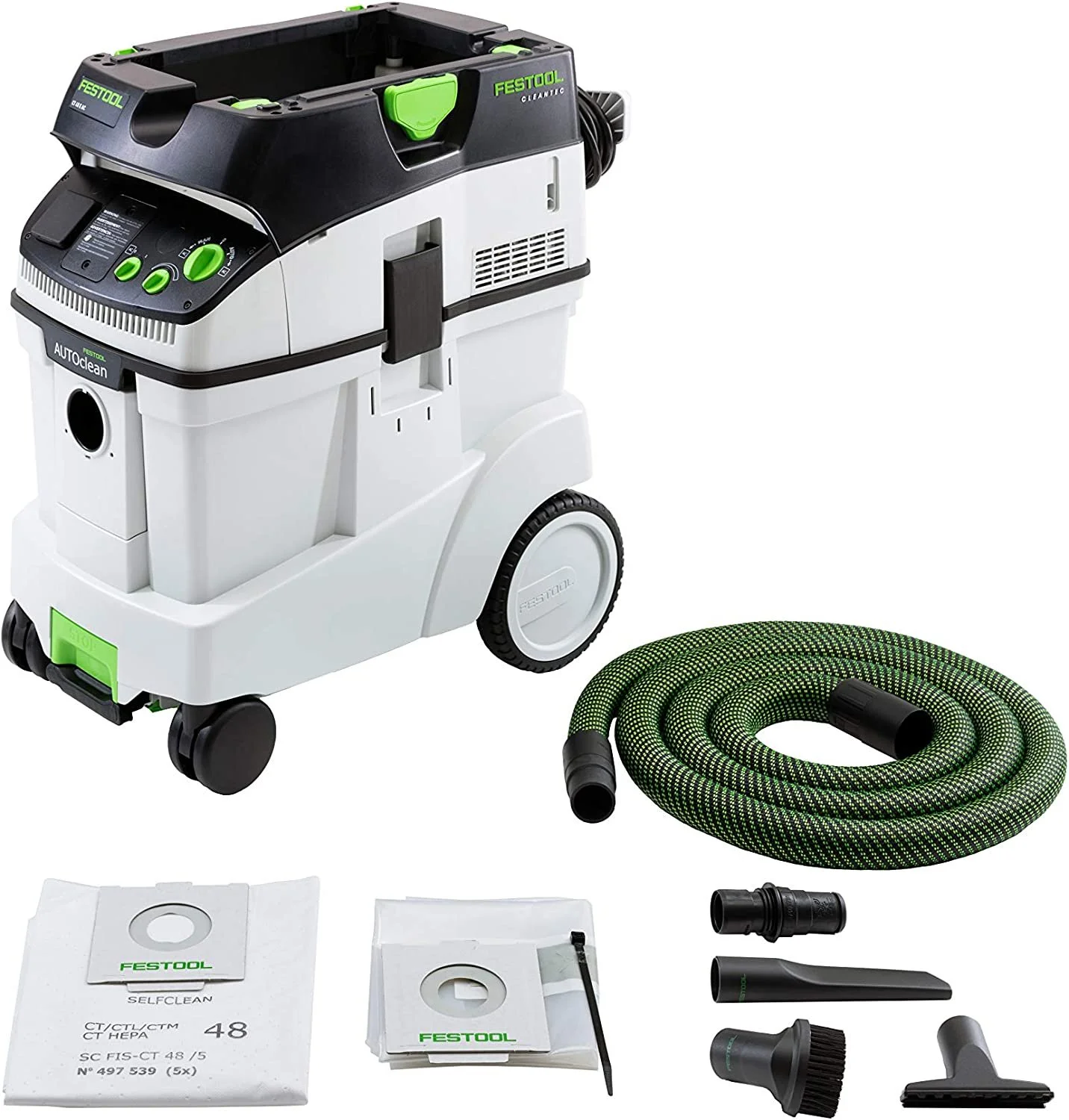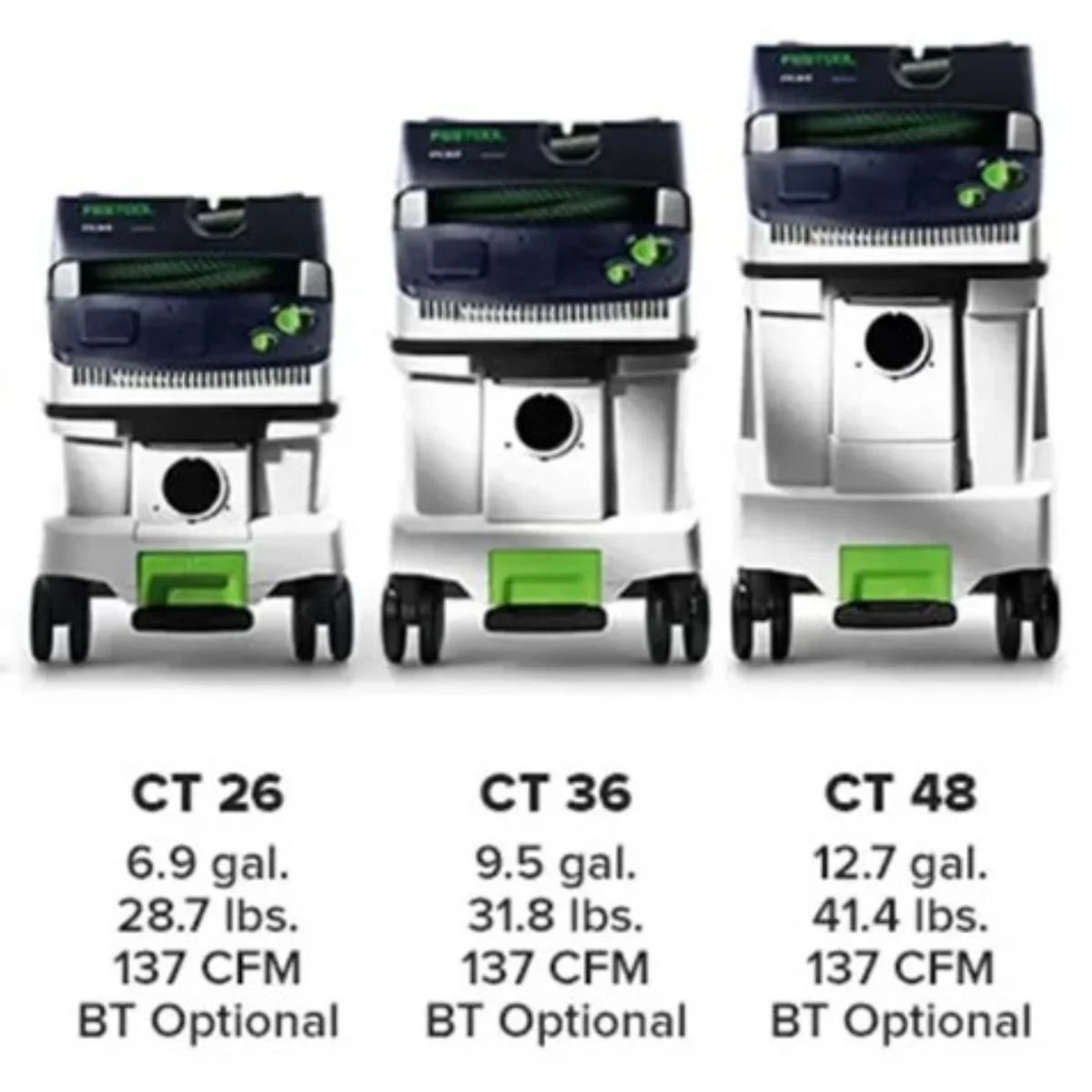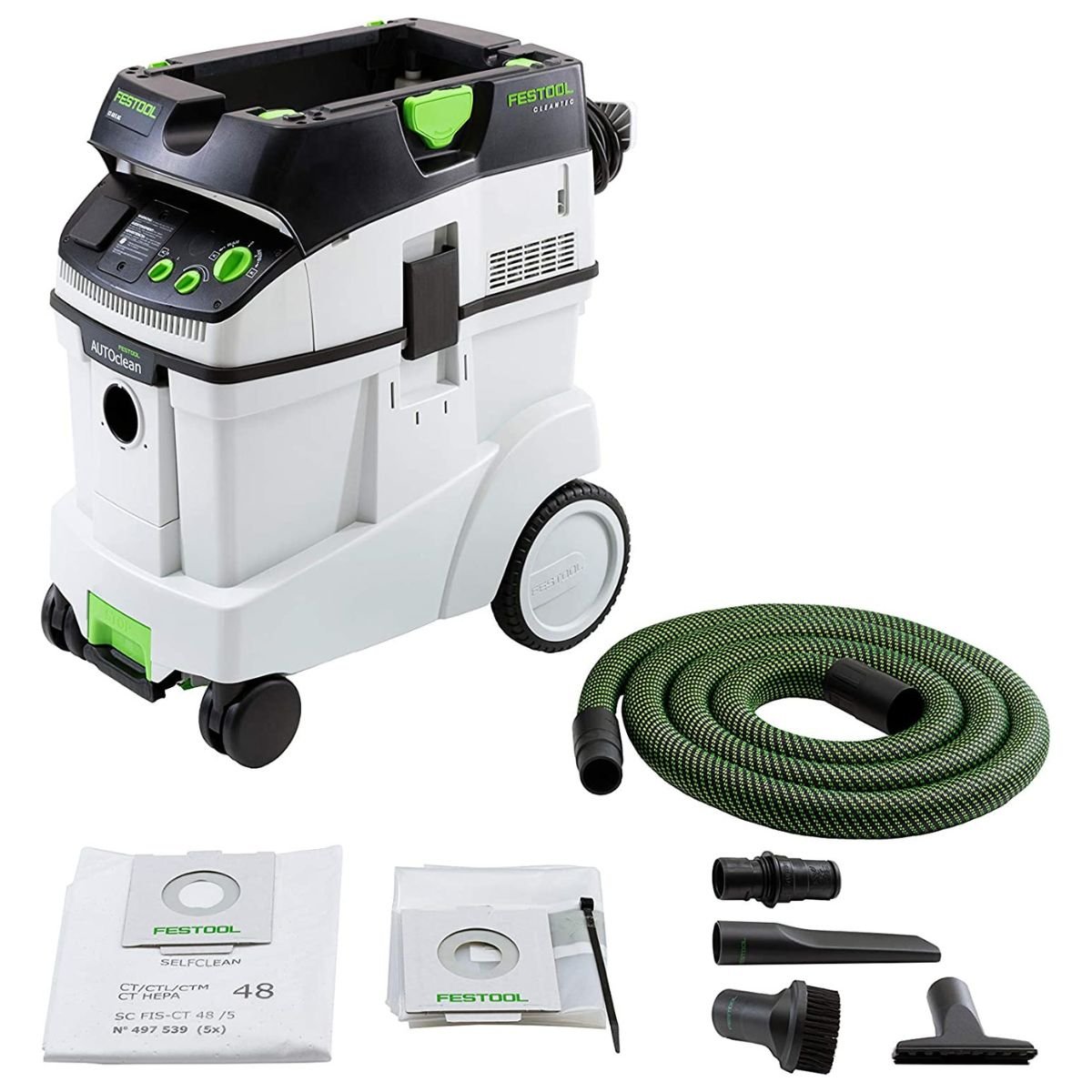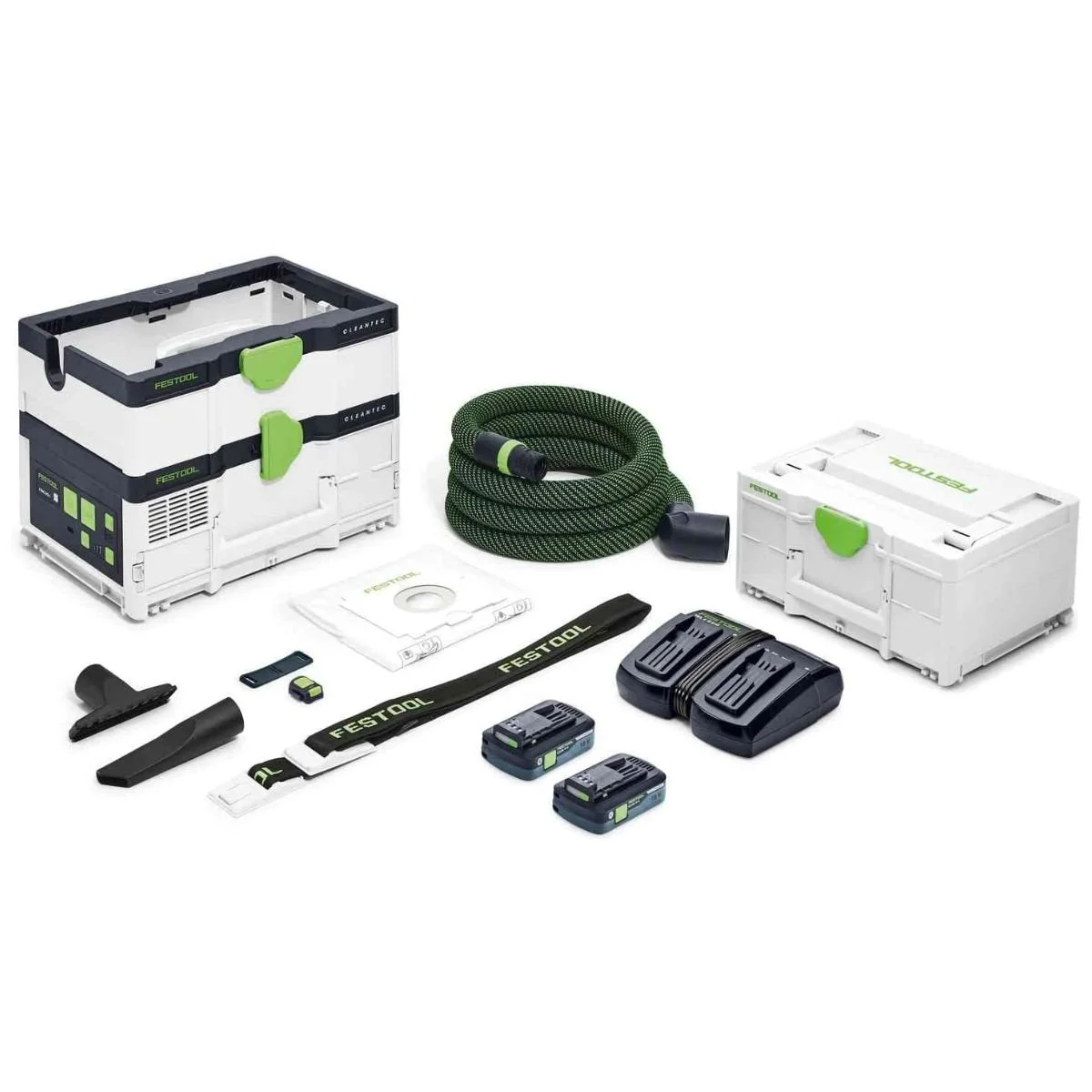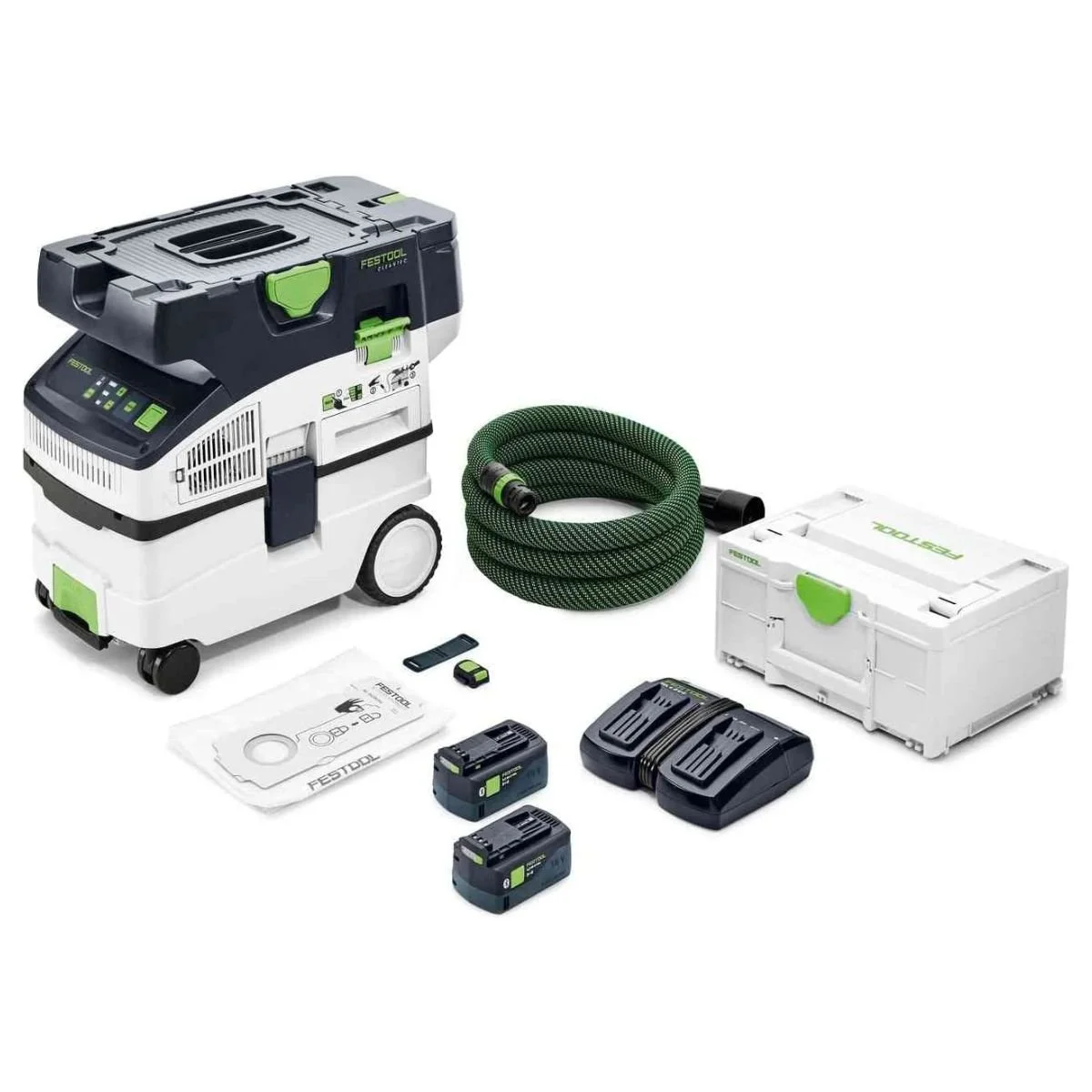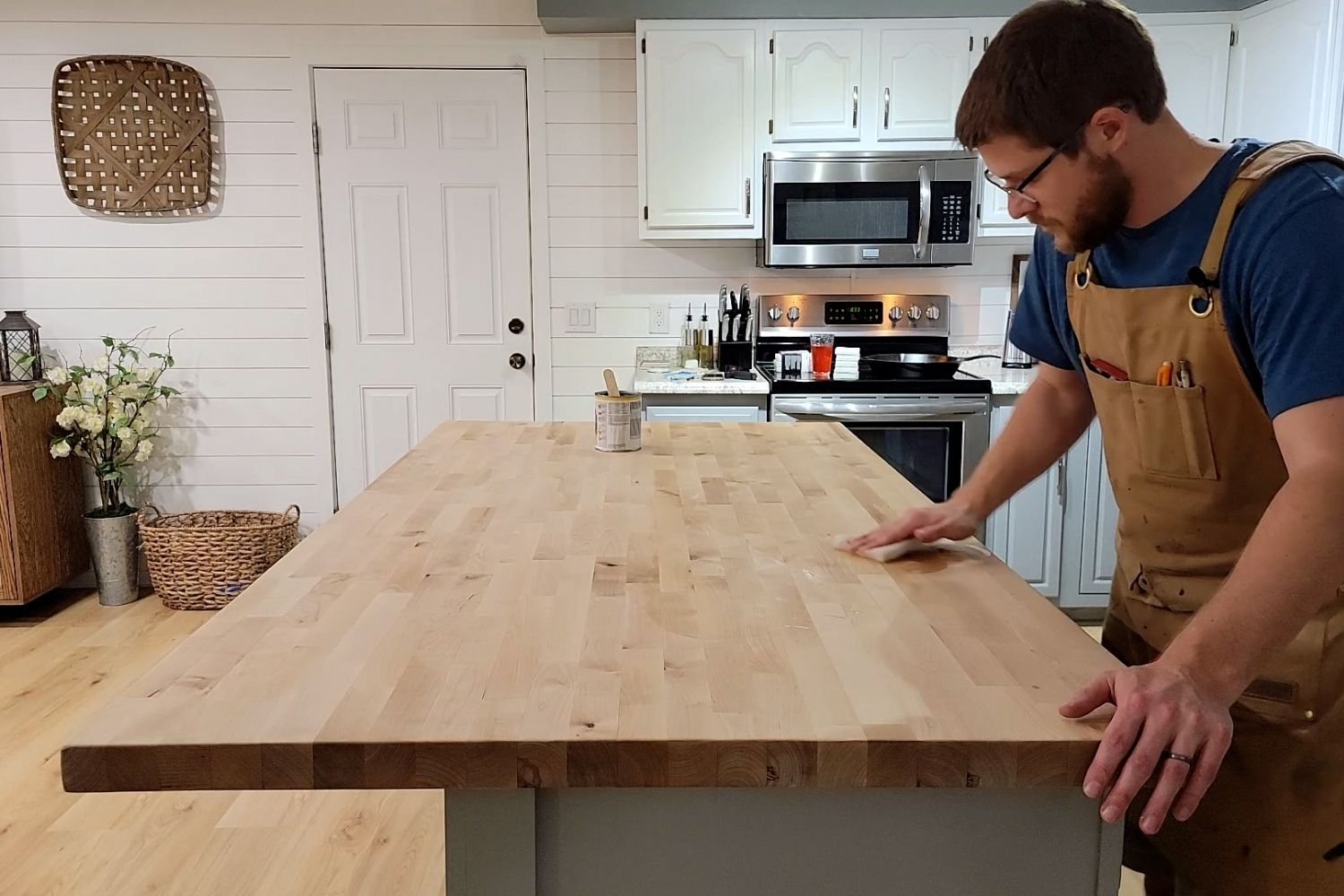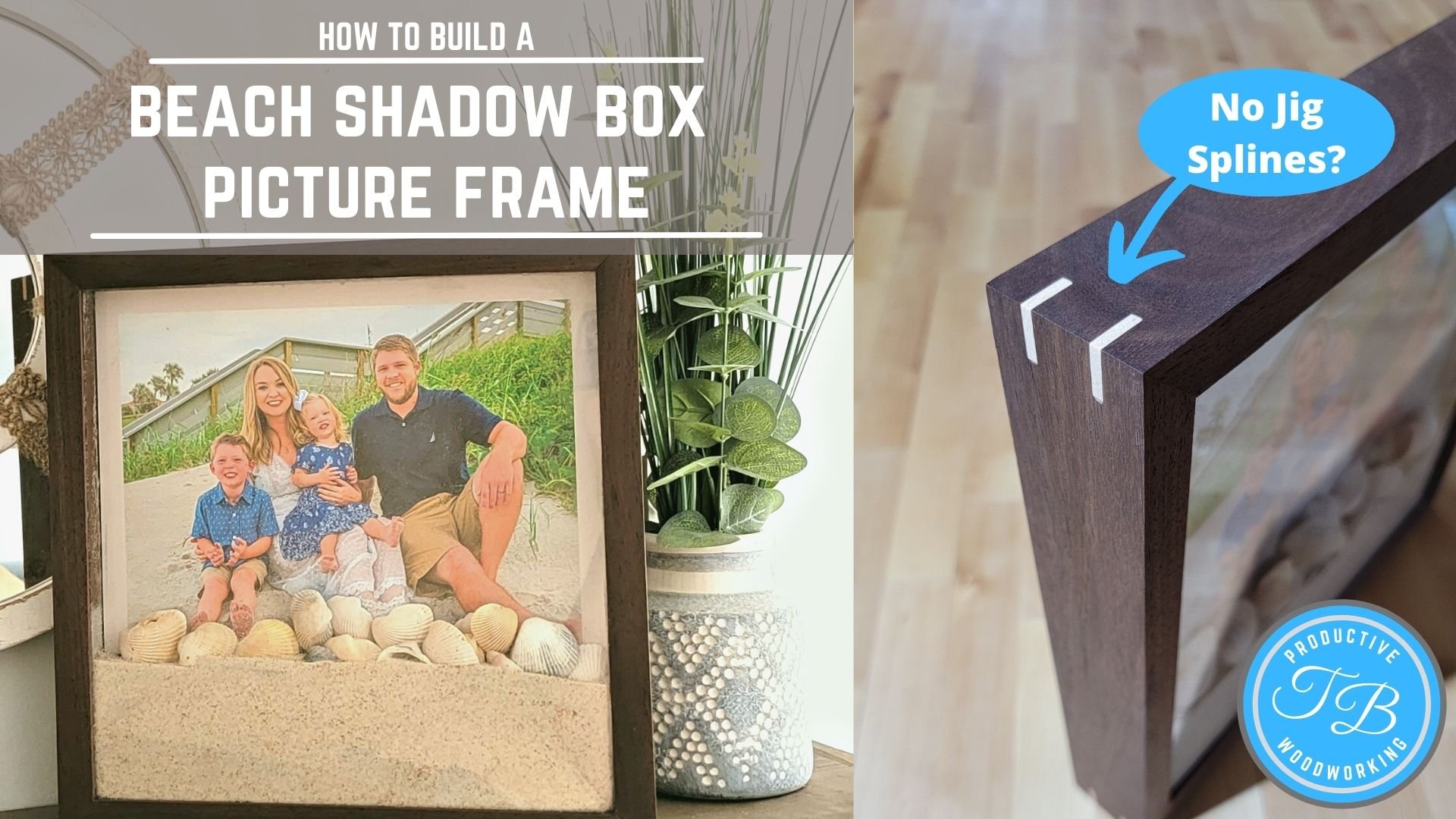Festool Dust Extractor Comparison (Best for 2025)
Selecting the right Festool dust extractor for your woodworking projects can be challenging, given the wide range of Festool Cleantec products and their unique features. To make this process easier, I’ve created this comprehensive guide to help compare the available Festool dust extractors, highlighting their features, capabilities, and how they differ. Festool vacuum’s naming conventions and model options can be confusing, but by the end of this article, you’ll have a clear understanding of which dust extractor is ideal for your workshop and specific needs.
Festool CT 15
Affordable, compact, and equipped with essential dust extraction features.
Festool CT 36
Perfect balance of capacity, power, and versatility for all tasks.
Festool CT 48 AC
Maximum capacity with auto-clean for continuous high performance.
Festool CTC MIDI I
Portable, powerful, and ideal for job site dust extraction.
Table Of Contents
We’re reader-supported. When you buy through links on our site, we may earn an affiliate commission at no cost to you.
Festool Dust Extractor Models Explained
Similarities
The 9 Festool dust extractor models share several key features, with the most notable being their advanced filtration capabilities. Every model is equipped with a HEPA filter capable of capturing 99.97% of particles as small as 0.3 microns, ensuring exceptional air quality. Additionally, all models include variable suction control, allowing you to fine-tune the suction power for different tools and tasks. While I initially didn’t see the need for variable suction, I’ve found it invaluable for preventing swirls and imperfections when using an orbital sander or a Festool track saw. Another standout feature of the corded models, such as the CT 26 E and CT 36 E, is the integrated remote outlet, which automatically powers the vacuum when a connected tool, like a miter saw or router, is activated. This feature, however, is not available on the battery-operated models. The built-in hose garage on these models also ensures unparalleled portability and helps store the hose neatly, keeping your workspace organized and dust-free.
Differences
While most Festool dust extractors share a similar appearance, there are notable differences across the models. Recently, Festool USA introduced the CTC series of battery-operated dust extractors, designed specifically for job site performance and portability. These models, including the CTC SYS, run on 36V battery power, providing flexibility for hand-held tools like the Festool Rotex sander or TS55 tracksaw. Unlike other Festool extractors, which offer fully adjustable variable speed control, the CTC vacuums are limited to a few preset levels, providing simplicity but less precision for specific tasks. Additionally, the AC line features high-performing extractors like the CT 48 E AC, which automatically cleans its main filter for consistently strong suction power and minimal maintenance. The MIDI line includes models with a manual filter cleaning mechanism, allowing users to quickly resume tasks like sanding. Many Festool extractors also support Bluetooth connectivity for remote activation; some models come with this feature built-in, while others can be upgraded with an add-on module, and a few do not support it. A key distinction between the models lies in their bag capacity and overall size, with larger options like the CT 36 E or CT 48 E offering significant advantages for heavy-duty applications. Other differences, highlighted in the comparison chart, include hose storage, Systainer docking compatibility, cord length, weight, maximum volume flow, and whether they include an anti-static hose or additional accessories. These extractors are designed to handle harmful dust, such as silica dust, with robust construction to ensure durability on demanding job sites.
Detailed Festool Vacuum Comparisons
Festool CT MIDI I
The Festool CT MIDI I is a feature packed dust extractor in a compact form factor for increased portability. The dust extractor comes standard with a Bluetooth module, anti-static hose, variable suction, and a manual filter cleaning mechanism. The CT MIDI I is a great extractor for someone that needs portability but requires endless corded power and robust suction for larger power tools. The CT MIDI I has a max volume flow of 130 CFM which is right up there with the larger CT models. The only downside of the CT MIDI I is the smaller sized capacity of only 4 gallons or 15 liters. The dust extractor also comes with variable suction with 5 preset levels, whereas the other CT models have full customization of the suction power. When comparing the CT MIDI I vs the CT 15 there are a few differences with the biggest being the MIDI I includes hose storage or what Festool calls a hose garage as well as the ability to dock systainers on top of the extractor. In my opinion the Festool CT MIDI I is a great option if you need corded power with Bluetooth functionality but the portability of a smaller sized dust extractor.
Festool CT 15 (Best Budget Dust Extractor)
The Festool CT 15 is the cheapest and best budget option if you want a HEPA filter dust extractor, but it comes with a few downsides and a lack of some features. Due to the smaller footprint, the CT 15 doesn't have onboard hose storage or the ability to mount systainers on the top of the extractor. However, the CT 15 does have a rubber tie-down strap to secure the hose to the top. Another downside is the CT 15 is not equipped with Bluetooth capability and is not able to be upgraded with a Bluetooth module. The CT 15 does come with a crevice tool and upholstery brush as well as a dust hose and offers relatively the same level of performance as the larger CT models with 130 CFM volume flow. If you need something for a small shop and can live without a few of the storage features and Bluetooth functionality the CT 15 would make for a great investment and help keep your shop air clean.
Festool CT 26, CT 36, & CT 48 (Best Overall Dust Extractor)
The Festool CT 26, CT 36, and CT 48 models all share the same functionality and features with the only difference being the maximum volume of the dust bags. The CT 36 and CT 48 are just larger units with higher capacity with the number signifying the liter size of the machines with the CT 48 having 12.7 gallons of dust collection. The models all have hose storage on the top, the ability to mount systainers on the top, and cord management on the back. I wouldn't say they are the best machines for portability due to the size but they do have larger rear wheels which make it easier to move around and over debris. These models also don't come standard with Bluetooth but can be easily upgraded with an add-on kit for Bluetooth technology or even compressed air. All three come with anti-static dust hoses and fully adjustable suction with a maximum volume flow of 138 CFM. I personally have the CT 36 in my shop and I am honestly shocked at how well it does and did a full review of my experience. It captures nearly all the sawdust when it's connected to my sander or other power tools, whereas with a shop vac, I was getting a lot of dust in the air and all over my garage. If you’re interested in how well the CT models perform with a Festool sander I have detailed my full experience in another article. In my opinion, the Festool CT 36 model is the best overall dust extractor with a good balance between size, cost, and performance.
Festool CT 36 AC & CT 48 AC (Best Performance Dust Extractor)
Within the CT model line up Festool offers two of its top dust extractors with a proprietary feature called Autoclean (AC). The feature is offered on both the CT 36 AC and CT 48 AC which is an auto-cleaning feature designed to eliminate clogged filters and give you consistently high suction power. The integrated cleaning mechanism periodically shakes the filter knocking the dust from the filter and extending the length of time between swapping filters. All the features from the regular CT extractors carry over to both the AC dust extractors with only one difference with the CT 36 AC having a smooth suction hose that is designed for the Planex drywall sander. The CT 48 AC comes standard with the traditional anti-static hose that is more designed for woodworking applications. Overall the CT 36 AC is best for drywall applications whereas the Festool CT 48 AC is the top-of-the-line and best-performing dust extractor that Festool offers.
Festool CTC SYS (Cordless)
The Festool CTC SYS is the newest cordless dust extractor designed for jobsite use in a compact form that is small enough to fit between sets of systainers. The CTC SYS is designed for a contractor working in a client's home with other cordless tools that need dust extraction but only a little bit here and there. One downside of the compact form is a decrease in CFM to only 85 whereas the CTC MIDI I is 109 CFM and the others over 130 CFM. Also, the capacity is limited to only 1.2 gallons so if you use it a lot you will be changing the collection bags often. The CTC SYS comes with cleaning accessories, an anti-static hose, a shoulder strap, onboard hose storage, and a Bluetooth remote control. If you're already invested in the Festool ecosystem this is the perfect dust extractor for maximum portability at construction sites or in your client's homes. I would not recommend this model for a DIY woodworker or small home shop.
Festool CTC MIDI I (Best Cordless Dust Extractor)
The Festool CTC Midi I is the best portable dust extractor offered by Festool for numerous reasons. The CTC MIDI I is able to run off battery power and still produce 109 CFM of suction power making it perfect for larger Festool power tools. The CTC MIDI I also comes standard with Bluetooth capability and includes a remote control. The capacity is limited to only 3.96 gallons or 15 liters but is enough to handle most job sites while still having easy portability. Another feature that is unique to the MIDI models is the manual filter cleaning mechanism to quickly clean and extend the life of your filter while restoring suction power. The CTC MIDI I comes with cleaning accessories, an anti-static hose, a Bluetooth remote control, onboard hose storage, and systainer docking. In my opinion the CTC MIDI I is the best portable Festool cordless dust extractor with standard features similar to their larger models all in a portable footprint.
Festool Dust Extractor Accessories
Best Festool Accessories and Add-Ons
To get the most out of your dust extractor, there are a few accessories that you should really consider which is why I also created a list of the best Festool dust extractor accessories. The main accessory that is compatible with all the different models is the standard cleaning set that includes extension pipes, a curved handle, a suction brush, a crevice nozzle, and the floor nozzle. I personally use this set with my CT 36 and it makes cleaning up the shop and the sawdust around my tools really easy. Even though the set is expensive, I couldn't live without it. Another great accessory to consider to speed up your workflow is the Bluetooth remote control for the CT models. If you hate constantly going back to turn on the extractor manually this allows you to quickly hit a button from the end of the hose to turn it on remotely. If you primarily build very precise or high-dollar pieces of furniture you may want to consider the upgraded suction hose with integrated power cord and protective sleeve to protect the surface while you sand. Another great accessory that I highlighted above is the CT-VA Pre-Separator which can extend the length of your bags and minimize your operating cost. Most of the accessories you can live without but to me the standard cleaning set is a must-have.
Festool Standard Cleaning Set
Festool Bluetooth Module
Festool Suction Hose
Festool CT VA Pre-Seperator
Festool CT-VA Pre-Separator (Best Dust Extractor Accessory)
The Festool CT-VA is a cyclone separator designed to minimize the overall cost of keeping your dust collector running. It's Festool's version of a Dust Deputy but in a form that can easily be docked on top of your extractor and used with other systainers. It uses a 3-step system to separate large debris and dust particles from entering your dust collector and increases the time between bag changes and saving you money. The Festool CT-VA Pre-Separator is designed for woodworkers who plan to use their dust extractor on a daily basis or in a business because it will eventually pay for itself with cost savings on replacement bags and filters.
Which Festool Dust Extractor Should You Choose?
Whichever Festool dust extractor you choose will be a great investment and you won't regret your purchase because they are absolutely worth the money. I personally love my CT 36 and it made such a big improvement in my shop that I wish I had gotten it sooner. The Festool dust extractor you should buy depends on a few important considerations like the size of your workshop and usage as well as if you need portability or a cordless option. Personally, I believe the CT 36 is the best Festool dust extractor overall with all the necessary features, the ability to upgrade to Bluetooth, and big enough for any application. However, if you need a dust extractor that is portable for jobsite work the CT MIDI or the CTC MIDI are the best options due to their size and features.
To sum things up here are my top picks based on your specific needs:
Alternatives to Festool Dust Extractors
If you’re considering alternatives to Festool dust extractors, there are many excellent options from brands like Fein, Metabo, Mafell, Bosch, Makita, and DeWalt. Check out my in-depth article on the best dust extractors currently available to see how these models compare to Festool vacs like the CT 15 E or CT26. These alternatives often come equipped with features like durable hard plastic construction, high-performance dust ports, and compatibility with various shop vacuum setups. For instance, Bosch and Makita offer one of the larger extractors available that pair well with joiners, planers, and other tools, while Fein and Metabo models deliver impressive suction power.
Festool Dust Extractor Comparison Chart
Table Key:
S = Standard
O = Optional Add-On
- = Not Equipped or Not-Available
| Best Budget | Best Overall | Best Performance | Best Portable | ||||||
|---|---|---|---|---|---|---|---|---|---|
| CT MIDI I | CT 15 | CT 26 | CT 36 | CT 48 | CT 36 AC | CT 48 AC | CTC SYS | CTC MIDI I | |
| Hose Garage | S | - | S | S | S | S | S | S | S |
| Variable Suction | S | S | S | S | S | S | S | S | S |
| Anti-Static Hose | S | - | S | S | S | - | S | S | S |
| Auto-Clean | - | - | - | - | - | S | S | - | - |
| Manual Filter Cleaning | S | - | - | - | - | - | - | - | S |
| Capacity | 4 gal (15 l) | 3.96 gal (15 l) | 6.9 gal (26 l) | 9.5 gal (36 l) | 12.7 gal (48 l) | 9.5 gal (36 l) | 12.7 gal (48 l) | 1.2 gal (4.5 l) | 3.96 gal (15 l) |
| Power Source | Corded | Corded | Corded | Corded | Corded | Corded | Corded | Battery | Battery |
| Cord Length | 24.6 ft (7.5 m) | 16.4 ft (5 m) | 24.6 ft (7.5 m) | 24.6 ft (7.5 m) | 24.6 ft (7.5 m) | 24.6 ft (7.5 m) | 24.6 ft (7.5 m) | - | - |
| Remote Outlet | S | S | S | S | S | S | S | - | - |
| Bluetooth | S | - | O | O | O | O | O | S | S |
| HEPA Filter | S | S | S | S | S | S | S | S | S |
| Weight | 24.91 lbs (11.3 kg) | 24.69 lbs (10 kg) | 30.64 lbs (13.89 kg) | 31.75 lbs (14.4 kg) | 35.71 lbs (16.2 kg) | 33.51 lbs (15.9 kg) | 37.26 lbs (16.9 kg) | 15.65 lbs (6 kg) | 22.48 lbs (10.2 kg) |
| Max Volume Flow | 130 CFM | 130 CFM | 138 CFM | 138 CFM | 137 CFM | 138 CFM | 137 CFM | 85 CFM | 109 CFM |
| Systainer Docking | S | - | S | S | S | S | S | S | S |
| Cleaning Accessories | - | S | - | - | - | - | S | S | S |
Frequently Asked Questions
-
Festool's dust extractors are absolutely worth the money and make a big difference. I personally have the CT 36 and it has done a tremendous job capturing fine particles and helping to have clean air in the shop. I wrote extensively about my personal experience with my Festool sander and dust extractor combo and why I think it's a good idea to invest in them for your shop.
-
The size of the dust extractor you need depends primarily on how you plan to use it, but the larger the better. If you plan to use the dust extractor as your main dust collection system you need a huge container capacity so you're not replacing the filter bags as often. If you have a small shop and plan to use it with random orbit sanders or a Festool domino you can get away with saving money and buying a smaller unit.
-
The main differences between a dust extraction machine and a shop vac are the level of filtration and suction power. Typically a dust extractor will have HEPA filters and can filter out very fine dust and debris in contrast, a shop vac will blow out a lot of fine dust into the air and only capture larger particles. Shop vacs in my opinion should be used like vacuum cleaners and are not designed for fine wood dust whereas, a dust extractor is specifically designed to provide a safe woodworking environment and capture harmful fine dust particles.
Related Articles
If you have any questions, comment below.
Let’s talk about it!
Affiliate links are used on this page. See my disclosure page for info on affiliate programs. The links do not cost anything extra to you! I receive a small percentage from the businesses you purchase from which help support creating content and helpful articles like this one!
